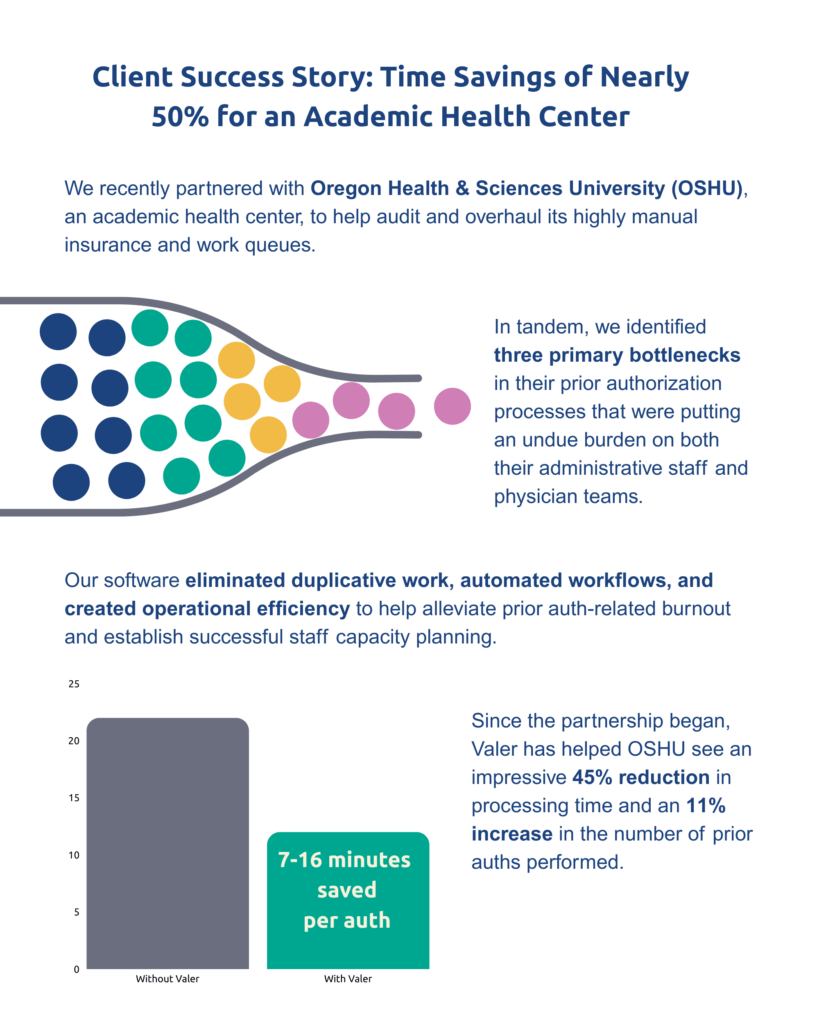By Dr. Steve Kim, Valer Co-Founder and CEO
Prior authorization is time consuming, complex, and expensive—at best. On average, one prior authorization, alone, takes 22 minutes to complete and costs provider organizations nearly $11. At worst, prior authorization is a hazard. It can impede delivery of timely and potentially life-saving patient care, limit protocol and care journey options, and contribute to burnout for clinical and administrative staff. It also compromises the financial health of provider organizations.

How are they doing it? It starts by uncovering—and better understanding—key information about prior authorization processes. This information, which is typically very difficult for providers to access, can then be leveraged to create more informed, effective, and impactful prior authorization workflows. In this blog, I’ll identify three of those prior authorization “blind spots,” and share how providers can uncover that hidden information to drive measurable improvements for their staff and patients.
Blind Spot #1: Turnaround Times
Patient care is on a ticking clock. There’s not usually much time to lose when prescribing medications, recommending specialist follow-ups, or scheduling procedures. 80 percent of physicians report that care delays due to prior authorization result in patients abandoning their recommended courses of treatment.
That’s why payers’ turnaround times (TAT) are a particularly frustrating prior authorization blind spot. TAT can feel impossible to track, making it difficult to guess when a decision will come through. That, of course, makes it difficult to determine when to schedule appointments and procedures. This uncertainty can result in big problems, including time wasted due to appointment or procedure rescheduling, as well as higher rates of patient dissatisfaction.
To address this blind spot, we’ve developed a real-time reporting solution that provider organizations can use to determine the average time it takes to receive a prior authorization response from every payer they work with. This tool can get quite granular, with filters by payer, service type, service line, and so on.
While this information is eye-opening at a topline level, it is transformative at an operational level. Whereas scheduling is typically a guessing game, provider organizations can now establish automations that help manage calendars and select appropriate appointment or procedure dates based on historical TAT data.
Blind Spot #2: Staff Bandwidth
You know your teams are spending a lot of time on prior auth—but do you know just how much?
While in many industries, routine processes are standardized and quantifiable, healthcare is not so lucky. Prior authorization workflows are saddled with a high degree of variability. The factors are myriad: organization size, populations served, service lines or specialties, team structure, technology, and more—and they all have an impact on the amount of time spent processing prior authorizations.
How many FTEs do you have currently spending time on authorizations, and what is the average amount of work assigned to each? Is it too high? Too low? If these questions aren’t easy for your organization to answer, that’s not surprising and very typical.
Uncertainties related to prior authorization workflow benchmarks can impact everything from organization-wide financials and direct patient care to workforce retention and team morale. These uncertainties can limit capacity planning, staff productivity metrics, and accountability measures, and obscure the need for educational sessions, additional staff training, and even efforts to mitigate staff burnout.
We address these blind spots by providing healthcare providers with monthly staff productivity reports, broken down by individual user and service line. This provides a line of sight into what could otherwise become a black hole of staff time and effort. This makes it easy to set operational goals related to prior authorization (such as time it takes to process), and this helps administrators determine how much training time it takes to get new team members up to speed. This also helps teams account for month-to-month variability for capacity planning and staff resource allocation.
Blind Spot #3: Prior Authorization Ruling Patterns and Insights
It can be quite a challenge to try and predict whether a prior authorization will be approved or denied. Unfortunately, the data suggests it may be as random as it appears. In fact, studies reveal that 81.7% of all prior authorization rejections are successfully appealed.
This lack of clarity on how and why prior authorization decisions are made has a huge bearing on patient care, experience, and outcomes. Denials can delay critical patient care and result in lost revenue, patient leakage, and more. Not to mention the range of operational and administrative impacts on provider organizations, including wasted time due to resubmissions and rescheduling.
We can help your organization avoid these problems, by facilitating more successful prior authorization submissions—the first time. Our system collects data that identifies payers’ historical approvals and denials by CPT code, so that you can track patterns back to judgment reasons—and proactively adjust their rationales. For instance, if prior auths for a specific CPT code are typically rejected for a “lack of clinical data,” it is easy to readjust your submission process accordingly.
Navigating Prior Authorization With Clarity and Confidence
As a pediatric urologist who spent years practicing at Children’s Hospital Los Angeles, I’m all too acquainted with the challenges associated with prior authorizations. It’s why I co-founded Valer, and why my team and I work so hard to help other healthcare providers navigate the common blind spots with clarity and confidence. Instead of settling for dangerous outcomes and administrative chaos, provider organizations can take advantage of a better way.
Click here to connect with our team to learn more about how we could help your organization




